Instant springtime
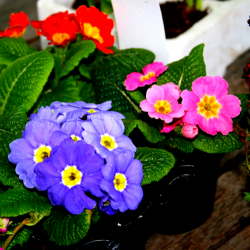
Spring Flowers in Containers
I have had to adjust my gardening activities from a small courtyard garden to an even smaller balcony, so I'm having to become accustomed to gardening in containers and the particular challenges that offers. I need to get used to it, or I'd be doing no gardening at all.
I'm going to show you here how I have given myself an instant display of spring flowers on my balcony this year, but all of this can apply just as well to any garden. I've always found that there are "quiet" periods or spaces, no matter how large an area you have, which would benefit from an instant display.
Although I describe them as instant gardening, I don't mean they should be short-lived or disposable. I'm expecting many of the plants and bulbs I've used to continue on for months or even quite possibly years.
All photos in this article have been taken by me and are my copyright.
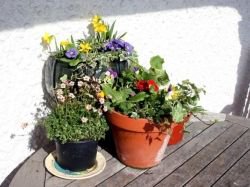
Planters and Containers
There is a huge choice of different containers you can consider: made from natural materials such as wood or terracotta, or from man-made plastics or composites. And they come in all shapes and sizes.
They all come with their own advantages and disadvantages.
Personally, I like real terracotta but its main disadvantage is that it allows the compost or growing medium of your choice to dry out quickly. It does also break much more easily than plastic and it may not stand up to winter frosts. On the other hand, its not so easy to over-water because water will seep through the terracotta, and it doesn't need an extra layer of drainage material at the bottom. An added bonus is that if you do end up with broken pots, the pieces do make good "crocks" for drainage in the bottom of another container.
Plastic containers don't dry out nearly so easily but are therefore much more susceptible to over-watering. You do need to make sure the drainage is good and that there is a layer of rough material, stones or crocks, at the base to help prevent the drainage holes becoming blocked.
In the end, however, you will have to be guided in size and shape by what will fit your space, what pots or troughs you already have or what pleases you. They all work perfectly well but here are some ideas which may be worth considering. I think you should go for the largest size possible for you. That will mean you shouldn't have to water and feed your plants quite so often, and so you'll have more time to sit back and enjoy the display.
Choosing the Flowers
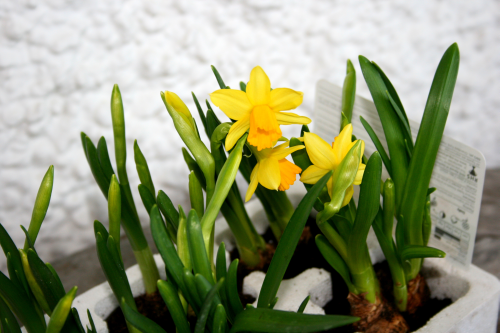
Well, in all honesty, I did nothing technical here. I started out by looking through books on container gardening and making lists of the plants they suggested. Of course when I arrived at the garden centre and started searching for what they recommended, they weren't available.
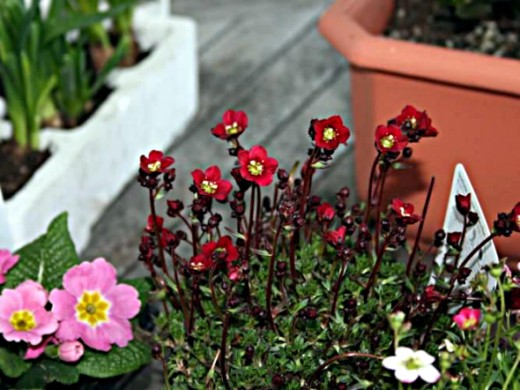
So I used a bit of common sense, instinct, and intuition, call it what you will. I chose plants taller for the back of the container, smaller ones for the front. I tried to co-ordinate the colour as far as possible, using similar shades with one or two contrasts. I chose some perennials which may (or may not) come up again next year, plus some that will have to be discarded when they finish flowering or at least making a nice show.
This saxifrage won me over with its beautiful colour, but also because I'm hoping it will continue flowering for quite some time. And yet another advantage, it is a perennial so with a bit of luck it will still be good for next year.
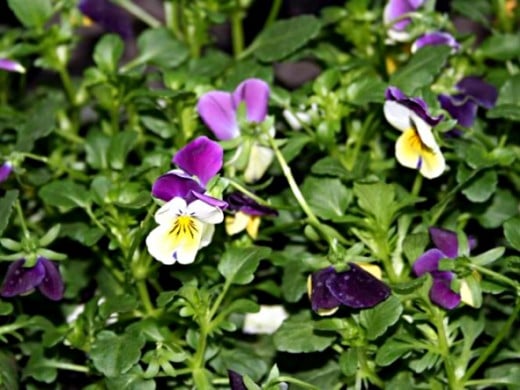
Anyone can do this, just follow your inclinations, but be guided by what the garden centre recommends for containers. You don't want anything that has rampant growth, or needs a lot of space in any direction, or takes years to mature. Choose what pleases your eye and if it isn't the success you hoped for, put it down to experience and try another combination.
These pansies are a little larger than violas but not as large flowered as most pansies I've seen. I hoped they would provide colour after the daffodils had finished. They can become quite straggly when they finish flowering so I suspect they will be candidates for discard, unless I can find a spot outside to keep them and review the situation next spring.
An interesting snippet or piece trivia: pansies are called "pensees" in French which sounds very similar and means "thoughts". In the language of flowers, pansies symbolise thinking or memories.
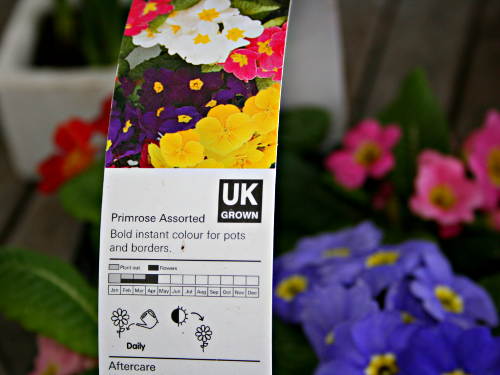
I chose primroses too, for the lovely splash of colour, for being low growing, and for lasting well. They should continue to flower for quite some time. The fact that they are UK raised has an influence too. If you buy locally grown plants, they are more likely to be well suited to local conditions and climate.
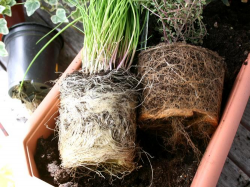
Be Aware of Your Roots
Try to choose plants that aren't as pot bound as these ones were. Pot bound means roots which have outgrown the pot they are in and have wound around and around to become very matted. I forgot to check these. You can usually tell by how much root is showing from the drainage holes of the pot or container the plants are in.
All is not lost, however, because you can gently tease out the roots before you replant them. These two were the herbs I bought and in fact they have done quite well as you can see from the following pictures.
Transformation
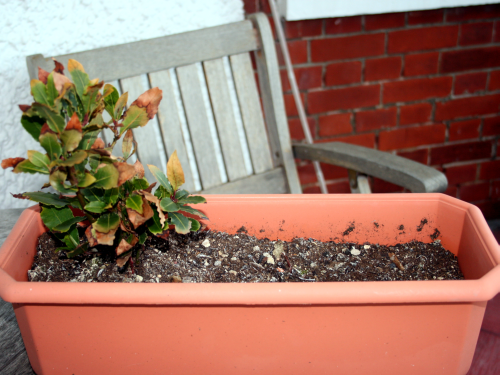
This was the very sad looking plant (a bay) that just about survived the winter, but none of my other herbs did.
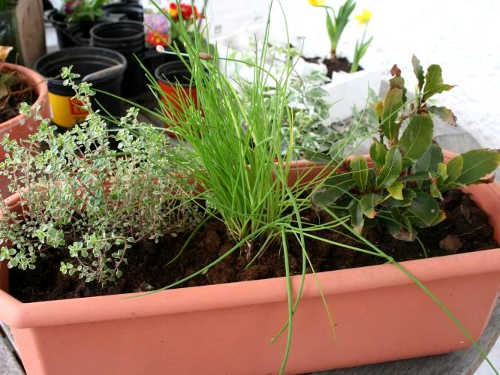
After I'd done a little pruning of the bay (and very happily finding some nice new shoots) and adding chives and thyme plants.
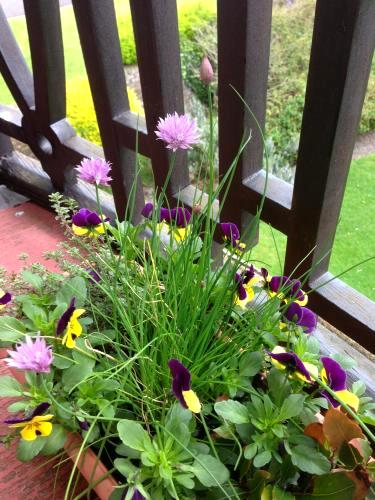
I then added a few pansies to fill up the empty spaces. This is what it looks like now. I am very pleased with it - both functional and decorative.
Window Box - The End Result
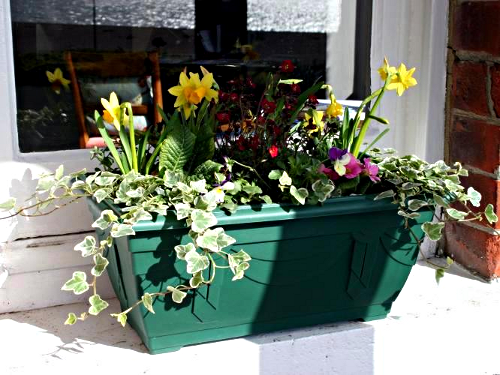
Here is my window box as it was planted up. You can see that I've added in some small ivy plants to soften the edges and as background filler.
The daffodils are the main focus along with the red saxifrage. Unfortunately I didn't take note of the shadow falling across the box as I took the picture so the saxifrage doesn't show up as well as I could have wished. I was pleased with it though.
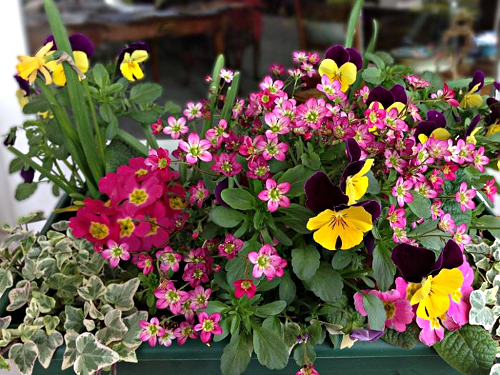
After a few weeks you can see that the daffodils have given way to the pansies and primroses, while the saxifrage continues flowering well.
To keep your containers looking good, it's important to water regularly (but check that it's necessary); to feed them approximately once a week; and to remove any old dying blooms or leaves. That way you can continue to enjoy your containers for months.
When any plants stop flowering you can decide whether to replace them with summer flowering plants, and in that way transform your instant springtime into instant summertime!
If you have any suggestions for planting in containers, please let me know. Or just say hello. :)








